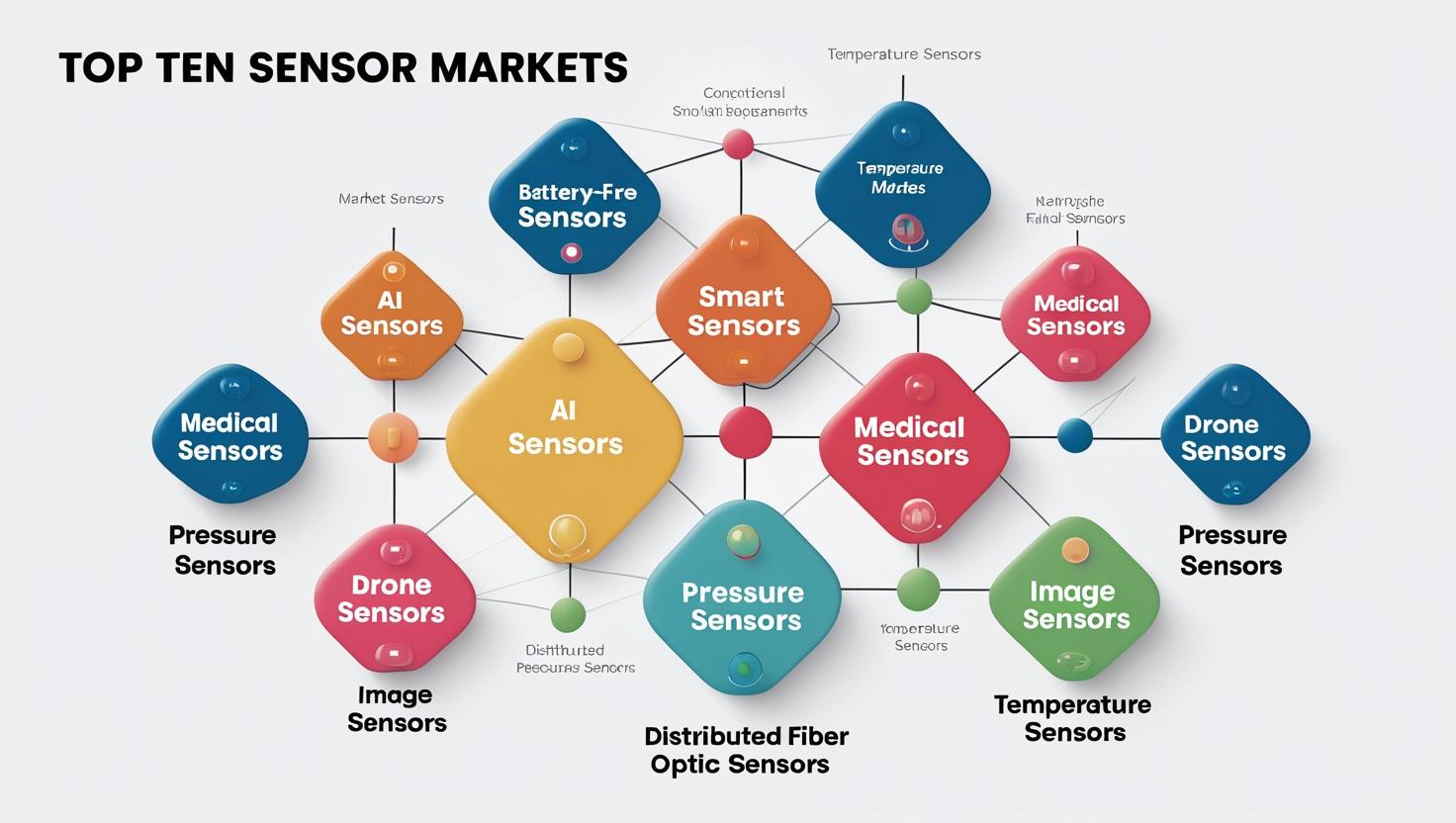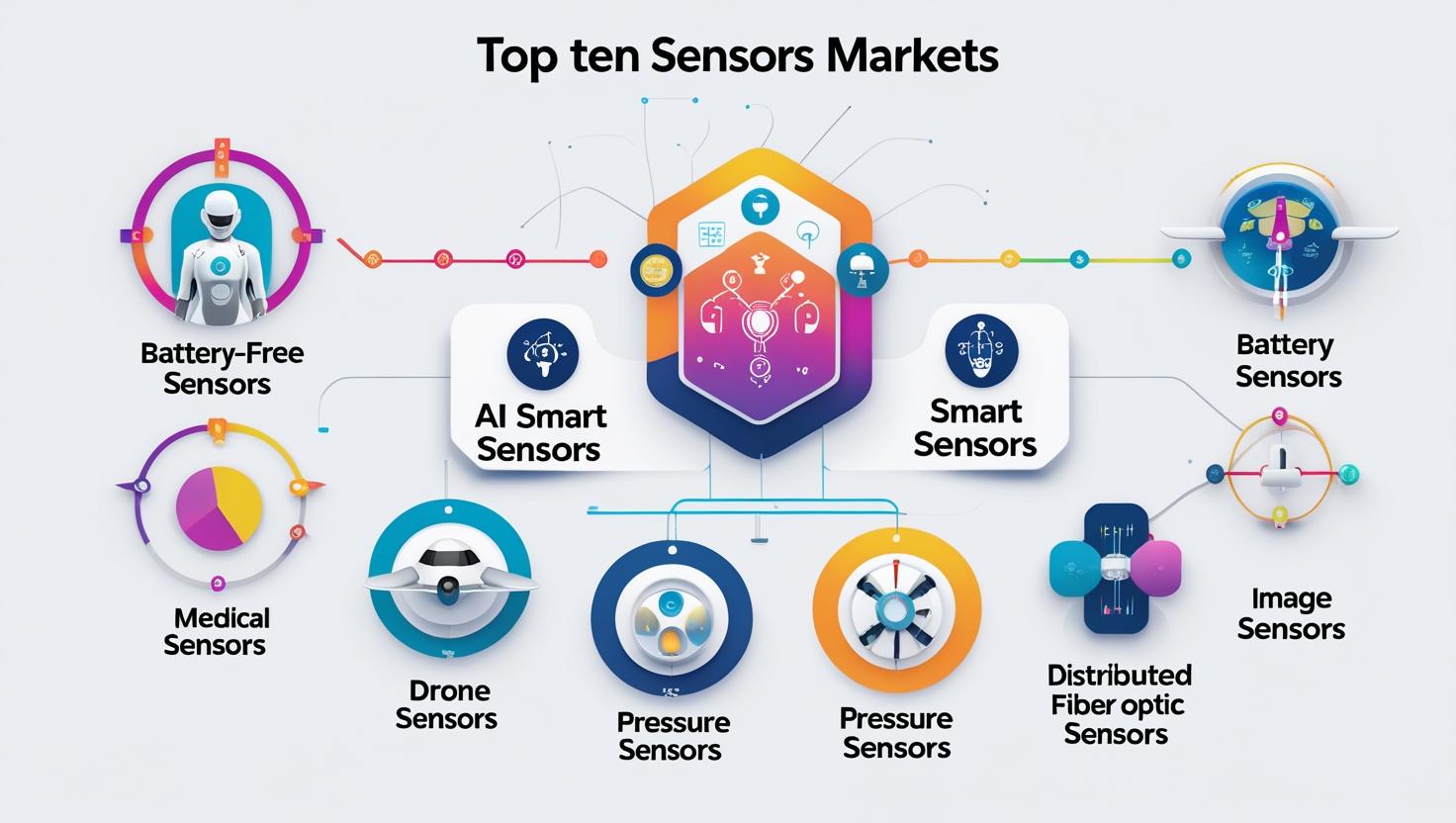The global economy is undergoing rapid transformation driven by technological innovation, climate awareness, and the pursuit of efficiency. At the core of this transformation is the sensor industry. Sensors are the unsung heroes of digitization and automation, providing the critical link between the physical and digital worlds. From improving healthcare outcomes to enabling sustainable cities, sensors are at the heart of every modern advancement. This article explores how the top 10 sensor markets align with the global megatrends of sustainability, automation, remote monitoring, healthcare digitization, and smart infrastructure.
Get More Information Download PDF Brochure :
https://www.marketsandmarkets.com/pdfdownloadNew.asp?id=194283584

Battery-Free Sensors: Powering Sustainability
Battery-free sensors are revolutionizing the concept of sustainable monitoring. By leveraging energy harvesting techniques—such as solar, thermal, or RF energy—they eliminate the need for disposable batteries, reducing electronic waste and operational costs. These sensors are especially valuable in hard-to-reach locations like pipelines, bridges, or remote agricultural lands, where battery replacement is impractical. Their self-sustaining nature supports long-term environmental monitoring, precision farming, and smart buildings. As organizations strive for greener operations, battery-free sensors offer a low-maintenance, eco-friendly solution.
AI Sensors: Enabling Automation and Intelligent Decision-Making
Artificial Intelligence (AI) sensors represent the fusion of sensing and edge computing. Unlike traditional sensors that simply collect data, AI sensors can analyze data in real time, making intelligent decisions at the point of sensing. This real-time responsiveness is crucial in automation-heavy industries like automotive, aerospace, and smart manufacturing. In autonomous vehicles, AI sensors help in obstacle detection, path planning, and adaptive control. Their integration supports predictive maintenance, reducing downtime and enhancing operational efficiency—core elements of modern automated systems.
Smart Sensors: Building the Foundation for Smart Infrastructure
Smart sensors combine sensing, processing, and wireless communication capabilities. They form the digital backbone of smart infrastructure systems—enabling smart grids, intelligent traffic systems, and connected industrial machinery. By providing real-time data, smart sensors help cities manage energy use, reduce congestion, and optimize public services. In factories, they enable predictive analytics and process optimization, fostering the transition to Industry 4.0 and 5.0. Their role is pivotal in creating responsive, data-driven environments that adapt to user needs and system changes.
Medical Sensors: Driving Healthcare Digitization
Medical sensors are central to the transformation of healthcare into a data-centric, patient-focused system. From wearable devices that track heart rate and oxygen levels to implantable sensors that monitor internal body conditions, these technologies empower remote care, early diagnosis, and real-time patient monitoring. The demand for non-invasive and continuous monitoring has accelerated post-pandemic, with healthcare providers embracing digital solutions for chronic disease management and telehealth services. Medical sensors contribute directly to improved patient outcomes and more efficient care delivery models.
Drone Sensors: Enhancing Remote Monitoring and Environmental Oversight
Drone sensors are enabling a new frontier in remote monitoring across industries. Equipped with cameras, LiDAR, GPS, infrared, and gas sensors, drones can access hazardous or unreachable locations to collect critical data. In agriculture, they monitor crop health and soil conditions. In environmental science, they track wildlife, measure pollution, and inspect ecosystems. Drones also play a vital role in infrastructure inspection, search and rescue missions, and disaster response. The ability to deploy sensors via aerial platforms significantly expands the scope of monitoring and data collection.
Pressure Sensors: Supporting Industrial Automation and Safety
Pressure sensors are essential in industrial automation, particularly in processes involving fluid or gas dynamics. They help maintain operational safety and system efficiency in sectors like oil & gas, automotive, and aerospace. Their role in monitoring HVAC systems, braking systems, and water management infrastructure is critical. Modern pressure sensors, enhanced with MEMS and nanotechnology, offer higher accuracy and miniaturization, making them integral to smart devices and compact automation systems. Their continuous feedback loops are key to ensuring system stability and safety in automated operations.
Image Sensors: Fueling Machine Vision and Smart Devices
Image sensors convert optical input into digital signals and are integral to machine vision systems. They are widely used in consumer electronics, industrial automation, autonomous vehicles, and security surveillance. Image sensors enable facial recognition, object tracking, and quality inspection processes. In smart cities, they are used for traffic monitoring, public safety, and license plate recognition. In healthcare, they power diagnostic imaging and telemedicine tools. Their application across such diverse domains underscores their importance in both automation and digitization efforts.
Distributed Fiber Optic Sensors: Monitoring Infrastructure in Real-Time
Distributed Fiber Optic Sensors (DFOS) use optical fibers to sense changes in temperature, strain, and acoustics across long distances. They are widely adopted in energy, transportation, and construction sectors to monitor pipelines, tunnels, bridges, and railways. These sensors provide continuous, real-time monitoring, helping detect faults or structural issues before they escalate. As governments invest in resilient and smart infrastructure, DFOS play a vital role in ensuring safety, maintenance, and optimization of critical assets over extended periods.
Temperature Sensors: Enabling Environmental Control and Efficiency
Temperature sensors are among the most widely used sensors globally, with applications in consumer electronics, HVAC systems, automotive, and manufacturing. They enable precise environmental control, essential for energy conservation and equipment longevity. In the context of smart homes and cities, temperature sensors help regulate building climates, improve energy efficiency, and reduce carbon footprints. In industrial automation, they are key to ensuring operational thresholds are maintained, thus preventing overheating, spoilage, or system failure.
Semiconductor and Electronics Market Research Reports & Consulting
Holistic Market Synergy: Toward a Smarter, Sustainable World
While each sensor market has its specific domain and function, together they form a comprehensive network that supports a smarter, more sustainable, and efficient world. Sensors are embedded in the fabric of daily life—monitoring health, controlling machines, gathering environmental data, and automating processes. The convergence of these technologies under global megatrends is accelerating innovation in every sector. Sustainability efforts rely on sensors for efficient resource use. Automation depends on them for precision and control. Remote monitoring and healthcare digitization require real-time sensing and feedback. Smart infrastructure wouldn’t be possible without sensors at its core.
The Future is Sensing Everything
As the world advances toward a more connected and intelligent future, sensors will play an increasingly central role. The top 10 sensor markets not only reflect the technological diversity of sensing systems but also their strategic importance in addressing global challenges. From reducing environmental impact to improving human well-being, sensors are the enablers of progress. Their alignment with megatrends such as sustainability, automation, and digital health positions them as critical assets for governments, industries, and societies worldwide. Investment in sensor innovation is not just a technological decision—it’s a strategic imperative for shaping a better tomorrow.

Q & A
1. What are battery-free sensors, and why are they important?
Battery-free sensors operate without traditional power sources, often using energy harvesting methods. They’re crucial for remote, hard-to-reach environments where changing batteries is impractical—such as in structural monitoring, logistics, and healthcare.
2. How do AI sensors differ from traditional sensors?
AI sensors combine sensing capabilities with embedded intelligence. Unlike traditional sensors that only collect data, AI sensors analyze and act on data in real time, enabling predictive maintenance, anomaly detection, and autonomous decision-making.
3. What makes smart sensors essential to Industry 4.0 and 5.0?
Smart sensors integrate sensing, data processing, and communication functions. They’re critical to smart manufacturing, energy systems, and connected homes because they provide real-time insights and seamless integration into broader digital ecosystems.
4. Why is the medical sensor market expanding so quickly?
Driven by aging populations, digital health trends, and the rise of telemedicine, medical sensors support real-time patient monitoring, wearable health tracking, and minimally invasive diagnostics—making healthcare more proactive and personalized.
5. What types of sensors are most commonly used in drones?
Drones use a mix of LiDAR, thermal, GPS, imaging, and proximity sensors for navigation, obstacle detection, and data collection. These enable advanced applications in agriculture, defense, disaster management, and last-mile delivery.
6. What innovations are shaping the pressure sensor market?
MEMS technology, miniaturization, and wireless connectivity are modernizing pressure sensors, making them more accurate and reliable. They’re widely used in automotive safety systems, industrial automation, and medical devices.
7. Where are image sensors seeing the highest demand?
Image sensors are in high demand across smartphones, autonomous vehicles, industrial inspection, surveillance, and medical imaging. CMOS-based image sensors dominate due to their speed, integration capability, and energy efficiency.
8. How are distributed fiber optic sensors different from conventional sensors?
Distributed fiber optic sensors measure environmental changes (like strain or temperature) continuously along the length of a fiber, unlike point sensors. They’re ideal for monitoring infrastructure such as pipelines, bridges, and tunnels.
9. What trends are impacting the temperature sensor market?
Digital temperature sensing, smart calibration, and IoT integration are reshaping the temperature sensor space. These sensors are essential in automotive, consumer electronics, HVAC systems, and industrial processes.
10. How do these sensor markets connect to global megatrends?
All 10 sensor markets align with global trends like sustainability, automation, remote monitoring, healthcare digitization, and smart infrastructure. Together, they enable intelligent, adaptive systems across nearly every industry.
